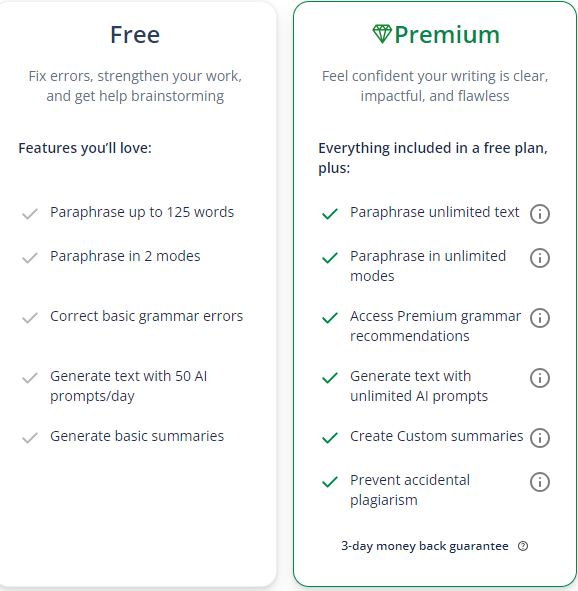QuillBot is a software that uses artificial intelligence to rewrite and paraphrase text. With a wide range of paragraph rewriting options, QuillBot promises to strengthen writing and boost productivity—without sacrificing authenticity. However, authenticity is virtually the state of being original. This post puts the promise of QuillBot to test, and investigates whether paragraph rewritten using QuillBot can evade detection by established platforms like Turnitin. By exploring the capabilities and limitations of QuillBot, we aim to shed light on the ai rewriter tool’s implications for authentic writing.
The QuillBot Paragraph Rewriter Test Experiment
Step-by-Step Process
i. Opening Accounts:

We will begin by setting up both QuillBot and Turnitin. We will open a QuillBot premium account for good measure. Among other features, the premium account provides a suite of features designed to rephrase and enhance text to prevent plagiarism. Conversely, Turnitin serves as a robust plagiarism detection service used by many educational institutions, so we will use it to check QuillBot content.
ii. Generating Original Content:
To start our experiment, we will generate a few paragraphs of original content using an AI-text generator, in this case ChatGPT. For this example, we’ll write a 300-word article titled “Why Humans Rewrite Better Than AI Tools.” This content, referred to as “pre-rephrased,” is the raw output without any human alteration.

iii. Testing AI Detection of Pre-Rephrased Content:
We will submit the original AI-generated text to Turnitin. Given its algorithms, we can expect Turnitin to flag this content as AI-generated or closely related to existing materials in its database. We will also submit the content to QuillBot AI detectors.

iv. Rephrasing with QuillBot:
Next, we will use QuillBot to rewrite the original paragraphs. Quillbot has various modes, but we will go for the “Standard” option, which promises to rewrite text with uniqueness while retaining the original message.

v. Testing Post-Rephrased Content in Turnitin:
Finally, we will submit the QuillBot-rephrased content to Turnitin to see if it still detects similarities to the original AI-generated text.
Below is the report of humanized content:

Experiment Report on the Paragraph Rewriter
We made the following findings based on the experiment:
- QuillBot Fails the Originality Test: The findings confirm that Turnitin can detect content altered by QuillBot. While the rephrased text may appear different in the face of it, there were many underlying similarities. As a result, the paragraph rewriter content was flagged for significant matches to the original, indicating that even with rephrasing, the AI signatures remain identifiable.
- Turnitin’s Advanced Tool Detects Content Rewritten by AI Tools: As part of the report, Turnitin highlighted the amount of content that had been rewritten by an AI tool. This means that Turnitin has advanced tools to counteract any content regenerated using AI tools or word spinners.
- QuillBot Content Does Not Meet the Basic Standards of Academic Writing. Content paraphrased by QuillBot often lacks the fluency and grammatical awareness of academic writing. As evidenced in the rewritten paragraphs, the rephrased output often lacks in authority, depth and insight, resulting in superficial interpretations. For instance, the last line in paragraph 1 is rephrased as “here is why” as if it were only one reason, then follows with a host of suggestions. These grammatical inconsistencies and awkward phrasing can detract from the overall quality of the initial output, making one question the reliability of QuillBot as a paragraph rewriter.
- Human Authorship Remains Key: The most reliable way to ensure originality is through genuine human writing. While AI tools can aid the writing process, they cannot replicate the critical thinking, creativity and rewriting skills inherent in human authorship.
CHECK SIMILAR EXPERIMENTS HERE:
- Can Turnitin Detect Undetectable Ai? [Screenshots]
- Can Turnitin Detect Originality Ai? [AI Paragraph Rewriter Experiment With Screenshots]
- Can Turnitin Detect Humanize Ai? [AI Paragraph Rewriters Experiment With Screenshots]
Why Will Turnitin Detect QuillBot and Other Rephrasing Tools?
QuillBot (and every other paraphrasing tools’) modus operandi is rephrasing text to obscure direct copying. However, as has been shown, it often fails to mask the original AI-generated patterns. The tool spins words and hopes it will bypass detectors. However, Turnitin is adept at detecting AI tools rewrites. Its algorithms are designed to identify subtle similarities in structure and meaning, thus making it difficult for rewriting tools to spin content and bypass it.
YOU CAN ALSO READ: How to Bypass Turnitin AI Detection with Ease
Is QuillBot A Better Paragraph Rewriter Compared to a Skilled Human Rewriter?
No, QuillBot cannot replace the nuanced capabilities of a skilled human rewriter. While it can assist in generating variations of text, it often lacks the emotional nuance, creativity, and contextual understanding that real human rewriters brings to rewriting paragraphs. True originality and depth are best achieved through human authorship, which allows for more comprehensive engagement with the subject matter.
YOU CAN ALSO READ: The 10 Unique Traits of Human AI Rewriters
Moving Forward
In conclusion, the experiment demonstrated that while AI tools like QuillBot can assist in rewriting paragraphs, their efficacy leaves a lot to be desired. Conversely, real human rewriters can bypass detection with greater accuracy. Humans possess a deeper understanding of context and tone, ensuring rephrased content remains coherent. This level of precision gives human rewriters an advantage in delivering nuanced and undetectable language adjustments that AI tools often miss.
Need your paragraph rewritten by real human rewriters, and not word spinners, to attain 100% originality?
